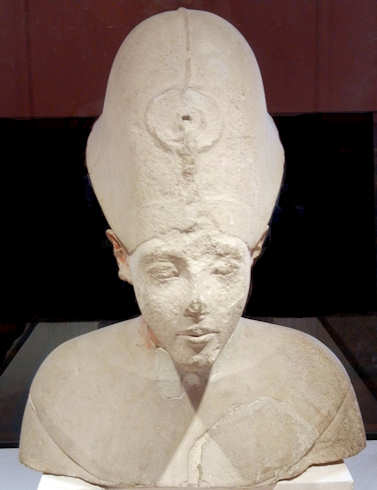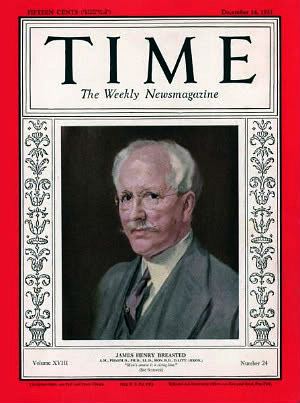| Go to previous page. |
Last Modified:
|

This is the story of the pharaoh Akhenaton. It is a tale of religious obsession. Or perhaps of mental illness. Or perhaps of an astute political gamble that failed. Or of total incompetence. It is a tale of the world's first known monotheist. Or perhaps of one of the world's great mountebanks. Or perhaps of a truly committed satirist.
Modern mystics sometimes claim Akhenaton as one of their own, perhaps the founder of a secret brotherhood persisting down through the ages. Modern novelists set stories in the religious and political tumult of his age.
There is no question that he neglected the political demands of his office, and a modern leader in his mold would surely be voted out of office. But did he have a higher calling?
Beginning with the successful decipherment of Egyptian hieroglyphics by Jean-François Champollion (1790-1832) beginning in 1822, it gradually became possible to make sense of thousands of inscriptions, on stone and papyrus and on countless art objects and objects of everyday use, which had remarkably been preserved from Egypt’s three-millennium-long “pharaonic” period (roughly 3100 BC to its conquest by the Romans about 30 BC). Throughout the late 1800s and early 1900s a number of impressively learned scholars immersed themselves in the task of transcribing and translating these texts and interpreting them in light of ever expanding archaeological finds.
In America, the most important of these people was James Henry Breasted (1865-1935), who was the first American to receive a doctorate in the new “science of Egyptology” which he studied in Berlin under another formidable Egyptologist of the age, Adolf Erman (1854-1937).

Between 1906 and 1907, Breasted published a five-volume collection of English translations of Ancient Records of Egypt. The following selection is from his influential 1905 work, prepared at the same time, A History of Egypt From the Earliest Times to the Persian Conquest. This extract is from its revised edition of 1909, a substantial rewrite made necessary by the identification in 1907 of the ancient Hittite capital in central Turkey and the flow of new information appearing from countless Egyptian archaeological sites, and an exuberant proliferation of additional texts.
Of course Breasted did not yet have access to all that we know today. The tomb of Tutankhamen had not yet been discovered, for example, and almost no archaeology had been done in Nubia, and pre-dynastic archaeology was in its infancy. On the other hand, a century of raiding and plundering of Egyptian antiquities together with industrial pollution and rising water tables has deprived us of some of the monumental inscriptions that were available to Breasted. For example, new evidence has caused some revision of the estimated dates of various events or reigns. Thus Breasted speaks of the death of Amenhotep III occurring in 1375 BC. More recent consensus would be slightly later, about 1349. And it now seems likely that Eye (now spelt Ay) occupied the throne for a couple of years after the death of Tutankhamon. And so on. Still, Breasted's understanding of Egyptian history remains, for English speakers, the text on which later works are arguably mostly footnotes.
The two chapters presented here are not the only possible interpretation of the people or events of this period. Indeed probably no figures in Egyptian history have captured more public interest than Akhenaton (Breasted’s Ikhnaton), and Breasted’s sympathetic but ultimately negative presentation of him does not please those who would interpret him as uniquely modern. But few later writers are closer to the relevant ancient texts than Breasted was, and none have been as influential.
Sections & Paragraphs. Breasted uses extremely long paragraphs, far longer than modern taste dictates or on-line viewing encourages. Accordingly I have introduced a great many additional paragraph breaks. In order to help the reader keep his place in reading as well as to preserve Breasted’s intent, I have added large colored numbers to Breasted’s original paragraph breaks to make, in effect, “mini-chapters” to which a reader can return if interrupted in reading. These are linked at the top of each page.
Abridged version. Because the text is a bit long, two versions are available, the "full text" and the " required passages" with frequent links to move between them.
Spelling. Because Egyptians did not mark vowels, their reconstruction has always been ambiguous. Breasted’s spellings of Egyptian names do not necessarily correspond with the spellings that are usual today. I have not modified them. Some modern spellings are provided in the "dramatis personae" list above.
Sources. Breasted wrote this book while simultaneously working through the translations that make up his monumental Ancient Records of Egypt. In this way he was able to anchor his history firmly in specific Egyptian inscriptions and other text materials and make the sources readily available to his reader. Not surprisingly, he makes frequent reference to that work in footnotes. Here his many bibliographic footnotes have been moved into the text, where they are displayed in brackets. Ancient Records of Egypt is abbreviated "ARE." PDF files of these five volumes are available from the Case Western Reserve Library (link).
Pictures. Breasted's original black-and-white illustrations are preserved here. (Color pictures have been added from other sources largely by way of decoration. Unless otherwise indicated, they show objects from the Musée du Louvre in Paris. Captions can be viewed by hovering your mouse over the pictures.)
Map. Towards the end of the article it may be useful to make use of Breasted's map of the Egyptian empire along the eastern coast of the Mediterranean. That map was not clearly printed in any editions of his book, and the labels are extremely small. Here it is reproduced at very large scale on a page by itself and will appear in a separate window in which you can move around it as needed. Clicking on the map toggles a couple of cropped versions that fit on the screen better, but it does not modify the size. A link to open the map window appears from time to time in the right margin of chapter 19. (Click for Map Page.)
Towards the end of the reign of Amenhotep III, the Hittite empire was expanding southward out of what is today Turkey and along the coast of Syria, threatening and sometimes assimilating Egyptian vassal states whenever they seemed weak. In competition with the Hittites, various eager warlords, sometimes nominally vassals of the pharaoh, were also seeking to carve out kingdoms for themselves in the same regions, or at least to plunder any settlement that could not be permanently seized.
Particularly talented and treacherous among these traitorous adventurers was one Aziru, whose defection from the Egyptian cause was of course reported to Amenhotep. Amenhotep, old and tired, probably underestimated the threat. He sent troops against Aziru. They stopped him, but did not kill him or end his ambitions.
But more importantly, Amenhotep failed to respond to the southern movement of the ambitious but officially “friendly” Hittites. Adding to the complexity of the situation, desert peoples (collectively called Khabiri by the Egyptians), who had tended to migrate towards the coast for centuries, seemed to be coming in greater numbers and were not usually friendly to Egyptian rule.
Finally, probably about 1375 BC or so, after a reign of 36 years, Amenhotep died.
Go to Chapter 18, Chapter 19